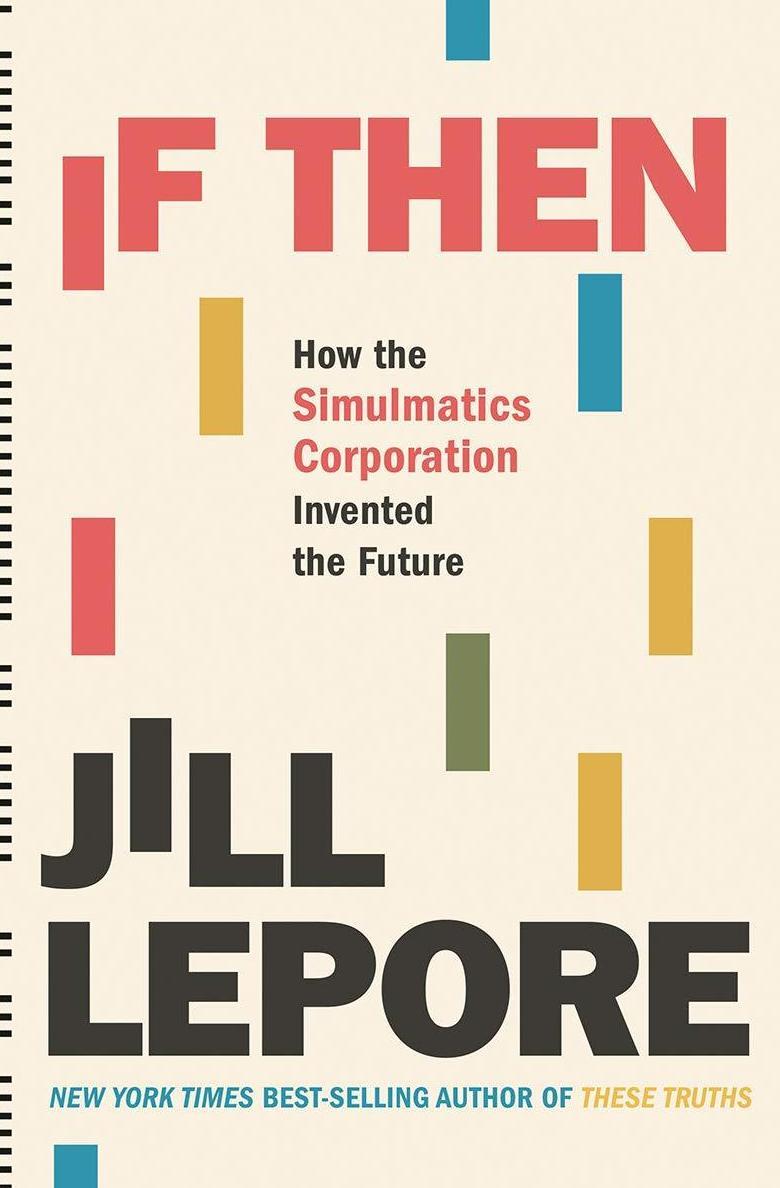Section Branding
Header Content
Collect Data, Influence Votes: 'If Then' Traces The Genesis Of Data-Driven Politics
Primary Content
Decades before Google or Facebook existed, a Madison Avenue advertising man started a company called Simulmatics based on a then-revolutionary method of using computers to forecast how people would behave.
Formed in 1959, Simulmatics charged clients a hefty fee to access its "people machine" — a computer program that drew on polling information and behavioral science to predict mathematically the impact of an advertising pitch or political message.
The New Yorker's Jill Lepore writes about Simulmatics in her new book, If Then: How the Simulmatics Corporation Invented the Future. She describes company founder Ed Greenfield as a "small-time operator" with an interest in liberal causes.
"He was a very devoted liberal ... and got into political consulting, which is what a lot of advertising agencies had done, mostly for Republicans," Lepore says. "But Greenfield wanted to bring political consulting to Democrats."
Simulmatics began working for the Democratic National Committee ahead of the 1960 election. Based on data prediction models, company analysts advised John F. Kennedy, then a long-shot candidate, to take a stronger position on civil rights.
"In the fall of 1960, everything that Simulmatics recommended Kennedy do Kennedy did," Lepore says. "And so when he won, Simulmatics took credit."
At the time, Simulmatics drew condemnation from scholars and political leaders who saw it as a threat to democracy. But now, 60 years later, the company's data collection practices and predictive models have become commonplace among political campaigns.
"They're collecting data about you in order to send you messages that will affect how you vote. That's now what our politics has become," Lepore says. "Especially [now that] we're stuck in our houses. That's really all that we have. We're not talking to people on the street or even answering the door or chatting with people about what we might do. We're just bits of data being manipulated."
Interview Highlights
On how she came across the story of Simulmatics
In 2015, I had an assignment from The New Yorker to write a kind of an assessment of the ... polling industry. And I wrote a piece called "Politics and the New Machine." And it struck me at the time, really early in my research, that polling is ... obsolete in that with the advent of data analytics companies, data science, modern data, modern political data science, you don't have to call somebody up and ask them a hundred questions to know how they might vote or what they believe about [Joe] Biden's latest speech or [President] Trump's latest action, because ... you can collect data about that. That's how politics actually works. So I was interested in that and for the purpose of the piece and answering, like, when did that begin? If polling is being replaced by data science, when did that begin? And then that took me to Simulmatics in the 1960 election work.
On the partnership between Simulmatics founder Ed Greenfield and "Wild" Bill McPhee
[McPhee] was a very erratic genius, and he worked in the field of voting behavior, trying to use what we know about election returns and public opinion polls to come up with a mathematical model that could tell you how to predict voters' behavior. And he came up with this thing for his Ph.D. dissertation, and then Greenfield ... said, "This is it! This is it! Ever since the election of 1952, I've been trying to find a way that we could use computers to influence political campaigns!" And so he brought McPhee on board, and he turned his doctoral dissertation into a commercial product that would found a for-profit company.
I think what Greenfield didn't quite get was McPhee was a little wild-eyed. During the time he was doing that research, he was manic depressive. His wife was home with young children, had him committed to Bellevue. Most of this work, he did a great deal of it, he did while in [the New York psychiatric hospital] Bellevue.
On how Simulmatics opened a debate about the future of democracy
I think the argument that wins out eventually, honestly, is the argument that's put forward by Ithiel de Sola Pool, who's the [Massachusetts Institute of Technology] political scientist, who's the chairman of the research board for this new company, Simulmatics. He says, you want a political candidate to have as much information as possible. This is information that our technology and scientific research is now able to provide to political campaigns. So who wants to stand in the way of knowledge? Knowledge is a good thing and progress will be when the other side also has a people machine. If we have two people machines fighting against one another, then that's fair. And that's actually the argument that wins.
On how Simulmatics, made up entirely of white men, was trying to understand Black people and women
What really struck me was so much anguish around the disconnect between these men. They're white liberal men trying to understand the mind of other people — the minds in particular of Black voters. So it's white men trying to understand Black people. And then the consumers were mainly women. So they're trying to figure out how women think. And meanwhile, they all treat their wives like crap. It's this horrible kind of a very bad bargain of 1950s marriages. Some of these people had decent marriages, but the rest of them, almost all of them, ended up in divorce and quite acrimonious divorces.
There's something that I think really prefigures the arrogance of Silicon Valley, where these guys, the sort of [Mark] Zuckerberg kind of guy who stands above us all and tries to figure out how women and people of color think and how they can be influenced. The irony of Simulmatics trying to figure out what message the Kennedy campaign should send about civil rights in 1960, when Black men are sitting in at lunch counters all across the South, Black men and women are demonstrating on the streets. Like, do we need to write a computer program to predict what the effect would be of taking a stronger position on civil rights for Black voters? It's kind of nuts, but it's also very much the world that we now live in. ...
It's really clear that this company — which is founded on a commitment to the idea that people who aren't white men are mysterious and need to be decoded by computers — kind of really can't endure the absurdity of that idea. It kind of collapses in on itself.
On Simulmatics doing public opinion research on Vietnamese peasants for the Department of Defense during the Vietnam War
They also did a lot of measurement of popular opinion among Vietnamese peasants. And so they would drive out with a military escort or be flown in to a village with teams of Vietnamese translators, most of these were college students, and ask questions. They would administer ... a really long questionnaire ... 100 questions about, like, if you had a television, what would you watch? They're trying to construct, essentially, a mathematical model of the Vietnamese peasant mind in order to figure out what are the right messages to be sending to these people to ensure their loyalty. It's cockamamie. But it is an extension of the logic of the voting research: You gather enough public opinion information, enough demographic information, and then devise a model and then you make a prediction. ...
The questions were largely, bafflingly irrelevant to these people's lives and the kind of daily suffering that they're enduring during this war. The whole thing is just kind of a travesty. And what surprised me a bit was how clearly the Defense Department understood that it was a travesty and yet continued to fund it. There's just file after file after file in the National Archives of people at the Advanced Research Projects Agency, part of the Department of Defense that oversaw the Simulmatics project, saying, "This stuff is nuts. These people are doing meaningless research, and we're paying them again and again and again for it."
On why Simulmatics disappears after the '60s
I think it completely vanished. I had certainly not heard of it. There's not really a scholarship about it. One of the reasons that it vanished is Ed Greenfield's own dissolution. Most of the records of the company were in New York, where the headquarters were, and the company filed for bankruptcy and ... pretty much [I] think all the archives were destroyed. ... There are no corporation records. ... A lot of what I had to do to work on this project was piece together the archives from different institutional collections.
On how the Simulmatics story connects to our current election
What Simulmatics started doing was really trying to convince the Democratic Party to count Black voters. Black voters matter, really, was Ed Greenfield's message. We're going to show you that mathematically. We're going to build a computer. We're going to build a machine that can show you that Black voters matter, because we need to be stronger on civil rights. It starts with this really noble commitment to civil rights.
But what it produces is the world that we have today, where we're all so segmented and micro-messaged to that we have no sense of the common good any longer. Which is how a democracy has to work. Like, we actually are not supposed to be going into a voting booth or sealing a ballot and sticking in an envelope and voting the way our demographic micro-segment says we must, because we're actually supposed to be looking at that ballot and thinking about what's good for everyone. That notion of the public good and the public interest, which is the ground on which a democracy stands, is falling away from beneath our feet.
Roberta Shorrock and Thea Chaloner produced and edited the audio of this interview. Bridget Bentz, Molly Seavy-Nesper and Meghan Sullivan adapted it for the Web.
Copyright 2020 Fresh Air. To see more, visit Fresh Air.
Bottom Content


